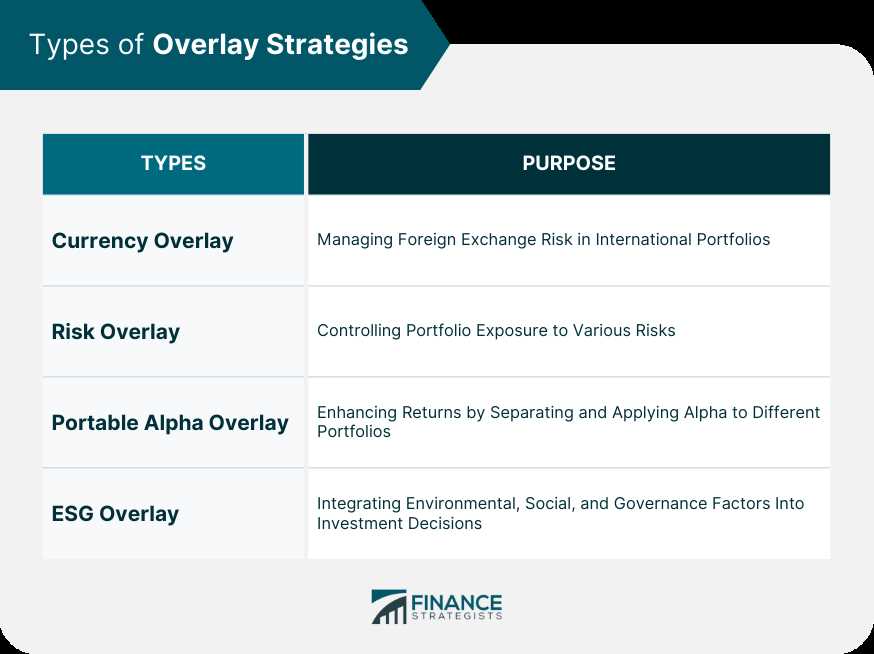What is Overlay in Portfolio Management?
In portfolio management, overlay refers to a strategy or technique that is used to enhance or modify an existing investment portfolio. It involves the addition of certain investment instruments or strategies on top of an existing portfolio to achieve specific objectives.
The overlay strategy can be implemented in different ways, depending on the goals and risk tolerance of the investor. It can involve the use of derivatives, such as options or futures, to hedge against potential losses or to generate additional income. It can also involve the use of active management techniques, such as tactical asset allocation or market timing, to take advantage of short-term market opportunities.
The main purpose of overlay in portfolio management is to enhance the overall performance of the portfolio by adding additional investment strategies or instruments. It allows investors to customize their portfolios and adapt to changing market conditions without completely restructuring their existing holdings.
One of the key benefits of overlay is its flexibility. It allows investors to implement specific investment strategies or tactics without making significant changes to their existing portfolios. This can be particularly useful in volatile or uncertain market conditions, where quick adjustments may be necessary to protect against potential losses or to take advantage of emerging opportunities.
Definition and Explanation

In portfolio management, an overlay refers to a strategy or technique that is used to adjust or enhance an existing investment portfolio. It involves adding additional investments or derivatives to the portfolio in order to achieve specific objectives, such as risk management or increased returns.
The overlay strategy is typically implemented on top of an existing portfolio, hence the term “overlay.” It is designed to complement the existing investments and provide additional benefits or protections. The overlay can be applied to various asset classes, including stocks, bonds, commodities, and currencies.
One common use of overlay in portfolio management is to manage risk. By adding derivatives, such as options or futures contracts, to the portfolio, investors can hedge against potential losses or volatility in the market. This allows them to protect their investments and reduce the overall risk exposure.
Another use of overlay is to enhance returns. By adding certain investments or strategies, such as leverage or alternative investments, to the portfolio, investors can potentially increase their returns. This can be particularly beneficial in a low-interest-rate environment or when traditional investments are underperforming.
Overlay strategies can be implemented by portfolio managers or through the use of specialized overlay managers. These managers have expertise in implementing and managing overlay strategies and can provide valuable insights and guidance to investors.
Pros and Cons of Overlay in Portfolio Management
Overlay in portfolio management can offer several advantages, but it also comes with its own set of disadvantages. It is important for investors and portfolio managers to carefully consider these pros and cons before implementing an overlay strategy.
Pros of Overlay in Portfolio Management:
1. Enhanced Risk Management: Overlay strategies can help investors manage and mitigate risks in their portfolios. By using derivatives or other hedging instruments, investors can protect their portfolios against market downturns or other adverse events.
2. Increased Flexibility: Overlay strategies provide investors with the flexibility to adjust their portfolios quickly and efficiently. They can be used to implement tactical asset allocation changes or to take advantage of short-term market opportunities.
3. Cost Efficiency: Implementing overlay strategies can be more cost-effective than making direct changes to the underlying portfolio. By using derivatives, investors can gain exposure to certain asset classes or market factors without having to buy or sell the actual securities.
4. Customization: Overlay strategies allow investors to customize their portfolios based on their specific investment objectives and risk tolerance. They can be tailored to meet the unique needs of individual investors or institutional clients.
Cons of Overlay in Portfolio Management:
2. Counterparty Risk: When using derivatives in overlay strategies, investors are exposed to counterparty risk. This risk arises from the possibility that the counterparty, such as a financial institution, may default on its obligations.
3. Increased Costs: While overlay strategies can be cost-effective in certain situations, they can also lead to increased costs. This can be due to transaction costs associated with implementing the strategy or the fees charged by overlay managers.
4. Limited Upside Potential: Overlay strategies are primarily used for risk management purposes, which means they may limit the upside potential of a portfolio. By hedging against market movements, investors may miss out on potential gains.
Overall, overlay in portfolio management can be a valuable tool for investors, but it is important to carefully consider the pros and cons before implementing such strategies. It is recommended to work with experienced professionals and conduct thorough analysis to determine if overlay strategies align with the investment objectives and risk tolerance of the portfolio.
Advantages and Disadvantages of Overlay in Portfolio Management

Overlay in portfolio management offers several advantages and disadvantages that investors should consider when implementing this strategy.
Advantages:

- Enhanced flexibility: Overlay allows investors to make adjustments to their portfolios without the need for significant changes to the underlying holdings. This flexibility enables investors to respond quickly to market conditions and make tactical asset allocation decisions.
- Cost-effective: By using overlay strategies, investors can achieve their desired exposure to specific asset classes or investment styles without incurring the costs associated with buying or selling individual securities. This can result in lower transaction costs and improved overall portfolio efficiency.
- Risk management: Overlay strategies can be used to manage risk by implementing hedging techniques, such as using derivatives to protect against downside risk. This can help investors mitigate potential losses and protect their portfolios during market downturns.
- Customization: Overlay strategies allow investors to customize their portfolios to meet their specific investment objectives and constraints. This level of customization can help investors align their portfolios with their unique risk tolerance, time horizon, and investment preferences.
- Efficient tax management: Overlay strategies can be used to manage tax liabilities by implementing tax-efficient trading techniques, such as tax-loss harvesting. This can help investors minimize the impact of taxes on their investment returns and improve after-tax performance.
Disadvantages:
- Execution risk: Overlay strategies involve the use of derivatives, which can introduce additional risks, such as counterparty risk and liquidity risk. Investors need to carefully assess and monitor these risks to ensure they are adequately managed.
- Regulatory constraints: Overlay strategies may be subject to regulatory constraints and limitations, depending on the jurisdiction in which the investor operates. Investors need to be aware of these constraints and ensure compliance with applicable regulations.
- Market risk: While overlay strategies can help manage risk, they cannot eliminate it entirely. Investors are still exposed to market risk, and the performance of overlay strategies will depend on the accuracy of market forecasts and the effectiveness of risk management techniques.
- Costs: While overlay strategies can be cost-effective in terms of transaction costs, they may still incur additional costs, such as management fees or expenses associated with implementing derivatives. Investors need to carefully consider these costs and assess whether the benefits outweigh the expenses.
Overall, overlay in portfolio management can offer significant advantages in terms of flexibility, cost-effectiveness, risk management, customization, and tax efficiency. However, investors should also be aware of the potential disadvantages, such as complexity, execution risk, regulatory constraints, market risk, and costs. It is important for investors to carefully evaluate these factors and determine whether overlay strategies align with their investment objectives and risk tolerance.

Emily Bibb simplifies finance through bestselling books and articles, bridging complex concepts for everyday understanding. Engaging audiences via social media, she shares insights for financial success. Active in seminars and philanthropy, Bibb aims to create a more financially informed society, driven by her passion for empowering others.
